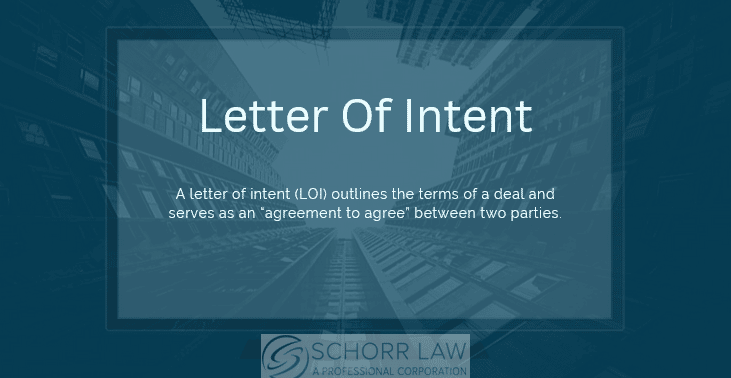

Updated on November 1, 2022
In the context of leasing, or buying and selling real estate property, letters of intent (often referred to as an “LOI”) are typically used by the parties to provide the proposed terms of the transaction.
While letters of intent may be used in both commercial and residential real estate, letters of intent are typically used in commercial real estate leases and purchases and not in residential transactions. (Residential transactions on the other hand, typically use a pre-printed offer or counteroffer form completed by the real estate agent or broker.)
Here are 5 key issues parties need to think about when preparing or receiving a letter of intent.

A simple letter of intent may be one to two pages long, while a complex one setting forth detailed contemplated terms may be 15 to 20 pages long. A simple LOI may set forth the amount of earnest money deposit, amount of loan, amount that will be paid in cash at the close of escrow, when escrow will open, amount of security deposit, and lease effective date. A lengthier and more detailed letter of intent may include a lot of the terms that will ultimately show up in the final lease or purchase and sales agreement, including terms of due diligence, inspection rights and obligations, financing, representations and warranties, title insurance, waivers, allocation of closing costs, remedies for default and liquidated damages, and commissions, among other topics.
Typically, letters of intent are prepared by real estate agents or brokers who are assisting with the lease or purchase transaction. However, it is a good idea to hire a real estate attorney in Los Angeles to review it before it is finalized and signed. Hiring an attorney to help you spot issues may help you ensure that the entire deal will not have to be reworked at a later date. It may also help you ensure that you do not inadvertently create contract terms when you do not intend for the LOI to be nonbinding.
A letter of intent may be binding or nonbinding, depending on the parties’ intent and the language of the LOI. It may also be nonbinding overall but have certain provisions that are binding, such as a confidentiality provision or provide the prospective purchaser or tenant certain reimbursement costs if the deal falls through. A nonbinding letter of intent is used for general discussion purposes only and is not an offer, acceptance, or contract.
A nonbinding letter of intent should include a disclaimer to make it clear that nothing contained in the LOI is binding on the parties. On the other hand, a binding letter of intent has terms that contain mandatory language in it (e.g., “The parties will…”) and may contain words such as “agree” and “agreement.” The distinction may not be very clear for an inexperienced party.
A party that is inexperienced in drafting the LOI may unintentionally draft a binding LOI where a nonbinding one was intended. Even where the LOI includes disclaimer language that it is nonbinding, it is still important to look at the other terms to determine whether the LOI is binding overall or there are portions that constitute an agreement between the parties.
A letter of intent is typically signed by the party making the offer (or counteroffer) and may have a space for the other party to indicate that the receiving party agrees to the proposed transaction. Nowadays letters of intent are typically transmitted by electronic mail and may be signed by DocuSign or may be a scanned ink signature. Electronic signatures are generally accepted in California (Cal. Civ. Code § 1633.7(d)), but please note that when a party denies that it signed a document electronically, the party seeking to enforce the signature may be required to introduce evidence showing that the electronic signature was authentic.
Our experienced real estate attorneys at Schorr Law is experienced in resolving disputes arising from both commercial and residential purchase and sales. If you have a question or would like to see if you qualify for a free consultation, please contact us today at [email protected] or (310) 954-1877.